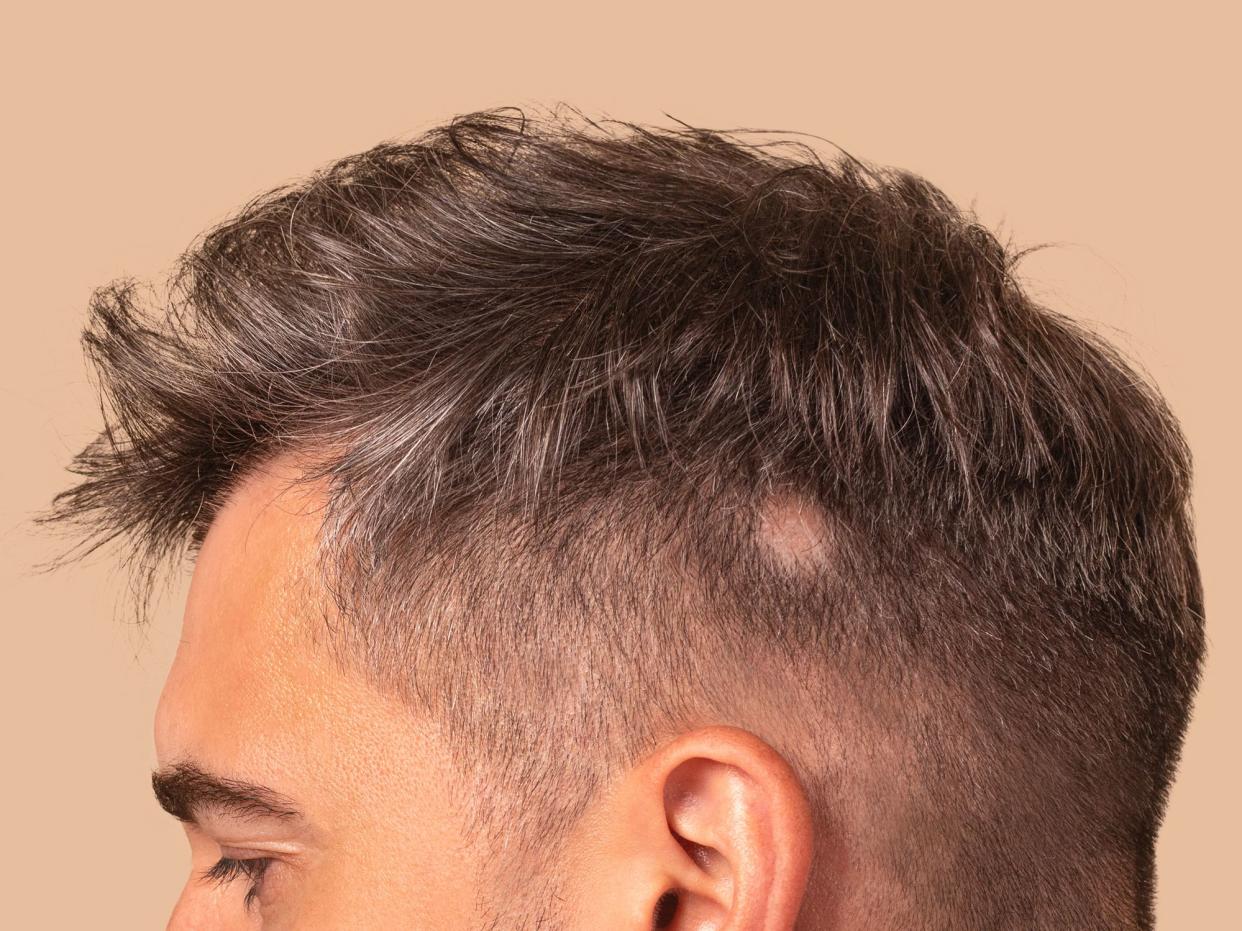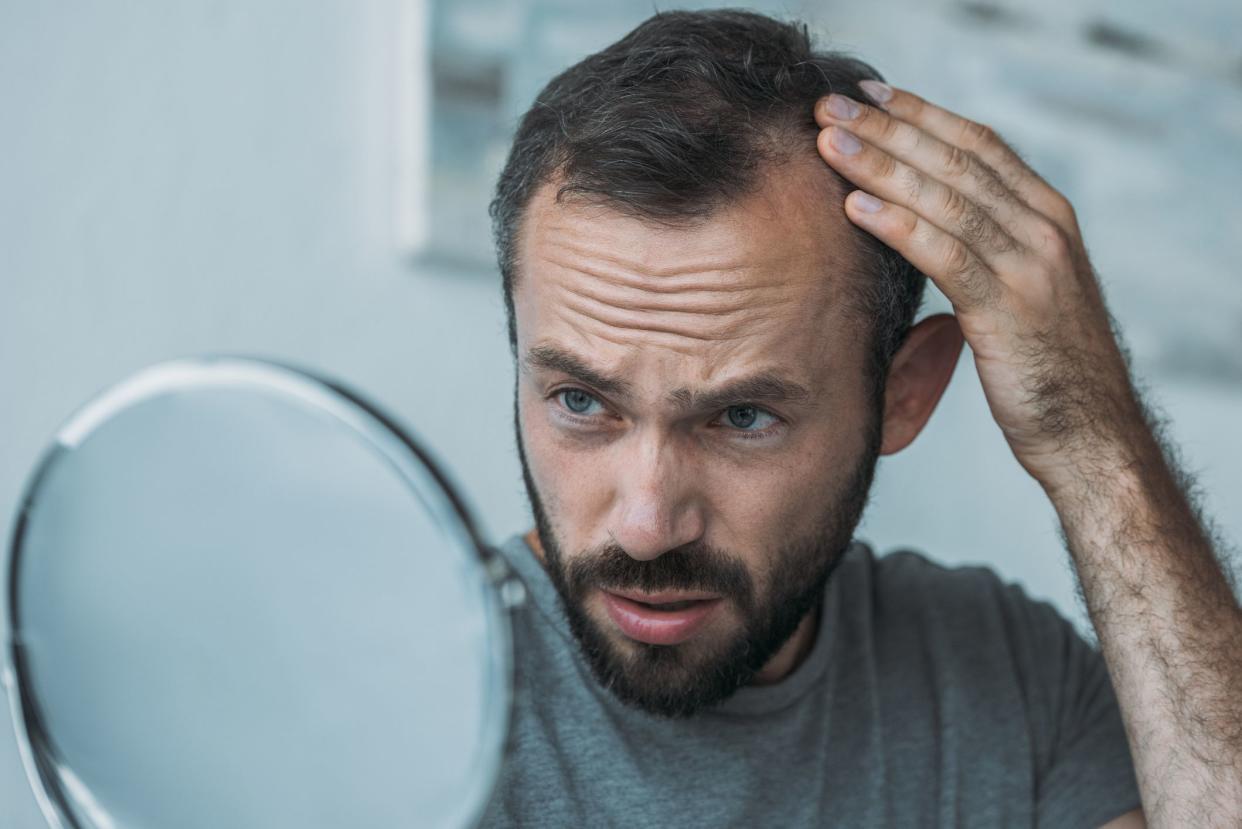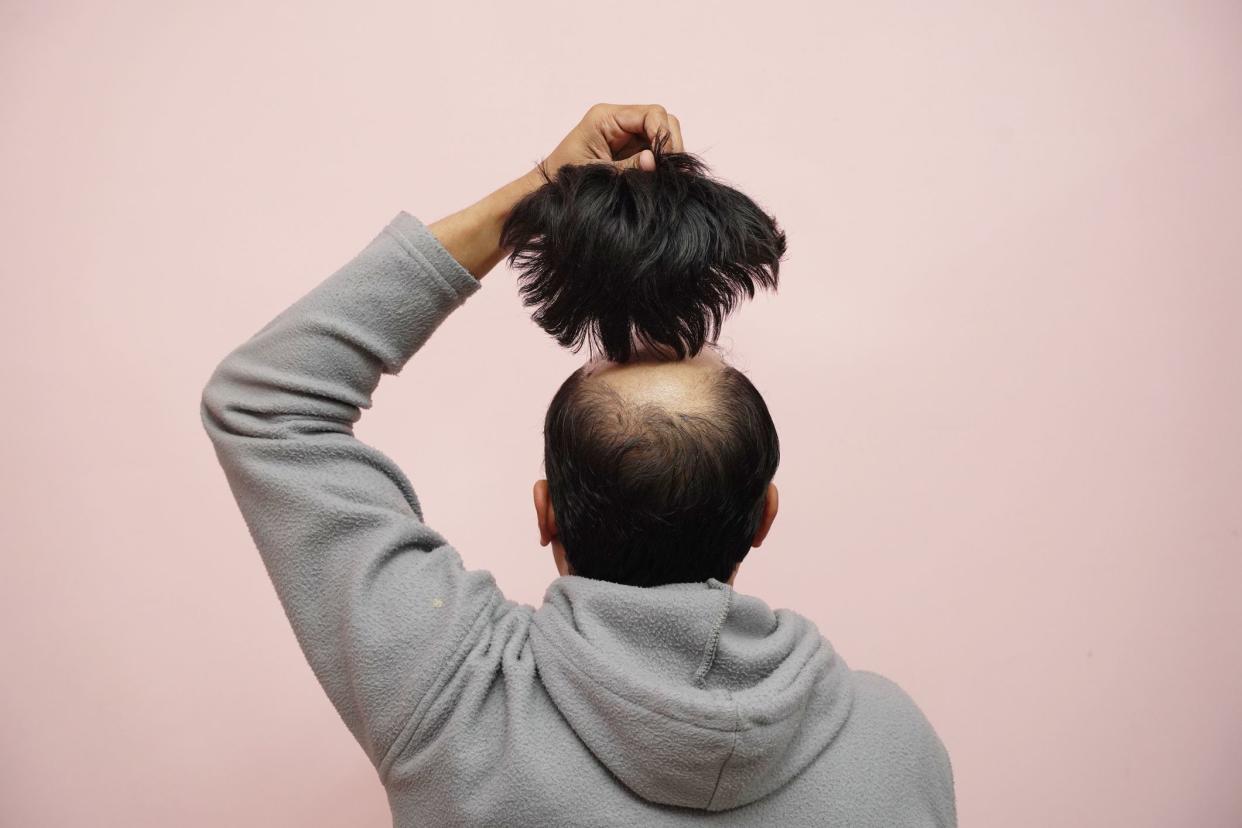What Are Bald Spots?
Reviewed by Knox Beasley, MD
If you’ve recently noticed a bald patch in your hair, you’re probably wondering when it showed up — and how soon it can be gone. In fact, a 2024 survey on surprising health findings by Hims & Hers (that’s us) found that 39 percent of Gen Z men take vitamins or supplements for better hair, and 38 percent have tried hair growth products in an effort to stave off baldness.
While bald spots are almost always treatable with medication, surgery, or changes to your hair care and styling habits, they are not always totally curable.
Below, we’ve explained how bald spots usually form, as well as the specific conditions that can cause them. We’ve also shared home remedies and medical treatment options to encourage hair regrowth, slow hair loss, or replace lost hair entirely.


What Causes Bald Spots?
The study we mentioned earlier found that 66% of Gen Z and Millennial men see hair loss as a midlife issue. However, the reality is that male pattern hair loss can start as early as a person’s 20s — or even sooner
Bald spots are different for every guy. Several different conditions can cause bald spots to develop. The most common is male pattern baldness, which affects approximately two-thirds of all American men by the age of thirty-five, but there are other medical conditions on the list of common causes of hair thinning, too.


Male Pattern Baldness: The Most Common Cause of Bald Spots
-
Male pattern baldness (also called androgenetic alopecia) is caused by hormonal factors, primarily your sensitivity to the androgen hormone DHT. We’ve talked about the hormonal causes of baldness more in our detailed guide to DHT and male hair loss.
-
Hair loss from male pattern baldness usually occurs in a specific shape or pattern. Some of the more common hair loss patterns involve bald patches that can develop close to your temples or around the crown of your head.
-
If you’ve noticed hair loss around your hairline or a bald patch at the crown of your head (the top of your skull), there’s a good chance that it’s the result of male pattern baldness.


Other Causes of Bald Spots
-
Small, patchy bald spots can also develop due to autoimmune diseases — specifically, a condition called alopecia areata, also known as “spot baldness.” Versions of this — alopecia totalis and alopecia universalis — can affect hair on your entire scalp or entire scalp and body. Alopecia areata occurs when your body’s immune system attacks your hair follicles. It causes small bald spots about the size of a coin to develop on your scalp and other body parts. Hair loss from alopecia areata generally isn’t permanent, meaning your hair may grow back once the underlying cause is treated.
-
A condition called telogen effluvium can be caused by stress, illness, and trauma. Certain infections, such as tinea capitis (scalp ringworm), can also cause patches of hair loss in some parts of your scalp. Tinea capitis, or scalp ringworm, is a type of fungal infection that develops on your scalp and in your hair follicles. It can cause patchy hair loss that affects different parts of your scalp, eyebrows and eyelashes. When tinea capitis causes inflammation (referred to as kerion) it can cause scarring and permanent hair loss.


How to Get Rid of Bald Spots
Bald spots can get larger quickly, making it important to talk to a licensed healthcare provider as soon as you notice you’re losing hair.
There are a number of ways to get rid of bald spots. In some cases, hair loss medications may help you regrow your hair. Other options include surgery, non-surgical procedures, or simply covering them up with the right haircut or styling technique.


Medical Treatments for Bald Spots
Most bald spots are treatable by using hair products for bald spots, using medication, making changes to your lifestyle, or undergoing surgery to transplant hair to the area that’s affected by hair loss.
Since several different conditions can cause bald spots, it’s important to accurately diagnose the cause of your hair loss before you start treating it.
To work out the specific cause of your hair loss, your healthcare provider may ask you questions about your symptoms. In some cases, your healthcare provider may take a sample of your skin or hair for testing to provide an accurate diagnosis.
Depending on the cause of your hair loss, you may be able to treat your bald spots using one or several of the methods listed below.


Use Minoxidil
Minoxidil is a topical medication that stimulates new hair growth. It works by making hairs enter into the anagen, or growth, phase of the hair cycle earlier than normal. It also lengthens the growth phase, allowing your hair to spend more time growing and less time resting.
Numerous studies have shown that minoxidil is effective at stimulating hair growth in men with male pattern baldness. It’s also effective at treating the patchy bald spots that can develop as a result of alopecia areata.
Currently, there’s no research available about minoxidil’s effectiveness for bald spots caused by tinea capitis.
Minoxidil starts working right away, but the results aren’t immediate. On average, you’ll need to keep using the medication for three to six months before you’ll be able to see improvements in your hair’s thickness and density.
We offer topical minoxidil online. You can learn more about how it works, its side effects, and how to use it in our full guide to applying minoxidil for hair growth.


Use Finasteride
Finasteride is a prescription medication that treats hair loss caused by male pattern baldness. It works by preventing your body from converting testosterone into dihydrotestosterone (DHT), the hormone that damages your hair follicles and causes pattern hair loss.
Several studies have found that finasteride is effective at slowing down or stopping the effects of male pattern baldness. One study even found that it can be effective at stimulating hair growth around the crown — a common area for bald spots.
Unlike minoxidil, finasteride isn’t an effective treatment for bald spots caused by alopecia areata or other non-hormonal causes of hair loss.
Although finasteride works quickly to block DHT, it usually takes three to four months to produce a noticeable improvement in your hair. For best results, consider using minoxidil and finasteride together to target your hair loss from multiple angles.
We offer finasteride online, following a consultation with a healthcare provider who will determine if a prescription is appropriate.


Treat Alopecia Areata
If you have bald spots caused by alopecia areata, it’s best to talk to your healthcare provider or dermatologist about treating the underlying cause.
Currently, there are no treatments that are effective for everyone with alopecia areata. However, some treatments may help to block the effects of your immune system on your hair and provide relief from your symptoms.
Common treatments for alopecia areata include:
-
Oral, topical, or injectable corticosteroids
-
Immunotherapy medications
-
Anthralin cream
-
Immunomodulators
-
Minoxidil


Treat Tinea Capitis (Scalp Ringworm)
If your hair loss is caused by tinea capitis, your healthcare provider may prescribe medication to treat the infection by killing the fungal cells and/or preventing them from multiplying.
Several different antifungal medications are used to treat tinea capitis. Even if your symptoms improve relatively quickly, make sure to take your medication exactly as prescribed for the full treatment period. This will help prevent the infection from returning.
Your healthcare provider may suggest certain habits and lifestyle changes to help you prevent the infection from coming back. We’ve talked more about these in our full guide to dealing with scalp fungus.


Surgical Options for Covering Bald Spots
There are two ways to address bald spots more invasively.
If you have significant hair loss and obvious bald spots but thick, healthy hair on the rest of your scalp, you may want to consider getting a hair transplant.
If the idea of undergoing hair transplant surgery to restore your hair isn’t appealing to you, you may want to consider scalp micropigmentation.


Get a Hair Transplant
Hair transplantation is a surgical procedure that involves removing hairs from the areas of your scalp unaffected by hair loss (typically the back and sides), then moving them to thinning areas or bald spots.
Performed correctly, this type of procedure can completely fill in your bald spots, making them look exactly the same as the areas of your scalp with naturally thicker hair.
Hair transplant surgery is usually performed to treat hair loss from male pattern baldness, but it may be used for other types of hair loss too.


Undergo Scalp Micropigmentation
This non-surgical procedure involves applying a special type of cosmetic tattoo to your scalp to create the illusion of shaved hair, stubble, or extra hair density. The pigments are chosen to be as close to your natural hair color as possible, with a similar look to a very short buzz cut.
Although this type of procedure doesn’t physically get rid of a bald spot, it can make small bald patches, scars, or other hairless areas much less visible.


Dietary Changes to Get Rid of Bald Spots
Changes to your diet may also promote healthier hair growth. While no medical advice says there’s a superfood in the natural treatments list, some research shows that getting more of specific foods and their beneficial compounds could improve your hair’s health and growth.


Caffeine
A few studies have indicated topical caffeine — even coffee shampoo — may reduce hair shedding and lessen the speed and intensity of hair loss. When combined with the traditional medication minoxidil, one study of 60 patients showed that caffeine improved results when compared with a minoxidil-only solution.


Curcumin
Curcumin may also be able to improve the effectiveness of minoxidil, according to one study published in the Journal of Dermatological Treatment. Research suggests it may increase the absorption of minoxidil into the skin, improving drug delivery; however, more research is needed.


Marine Proteins
Several proprietary marine protein supplements have been tested with potentially positive results, according to a study published in the International Journal of Trichology. These supplements generally include marine proteins and lipids, and are said to promote hair growth and decrease hair loss.


Cover-Up Options for Bald Spots
Hairpieces and other cover-up options can fit your style and meet your confidence needs without a blood test, a new FDA-approved pill, or a topical treatment like rosemary oil that may have an aroma.
Here are a few examples.


Wear a Hairpiece
While the idea of wearing a wig to hide a bald spot might seem a little ridiculous, a good-quality hairpiece can be surprisingly convincing.
Wearing a hairpiece may be an option worth considering if you have scarring alopecia — a type of permanent hair loss that destroys hair follicles in certain parts of your scalp.
We’ve talked more about hairpieces, or “hair replacement systems,” as they’re often referred to, in our guide to non-surgical hair replacement options.


Change Your Hairstyle
If you have a small bald patch that’s surrounded by areas with thick, dense hair, changing your hairstyle may help to make it less obvious.
There are two main ways to do this. The first is to stick with a short haircut like a buzz or crew cut. By cutting your hair nice and short, the contrast between the areas of your scalp with dense hair and the balding patches isn’t so obvious.
The second way is to cut the rest of your hair a little longer, then brush it forward, sideways, or back to cover the bald spot. Good haircuts for this include the mop top, slick back, pompadour, and quiff, all of which we’ve covered in our guide to the best haircuts for thinning hair.
Finally, there’s the most extreme option: just shave it off. If you like how you look without hair, this approach is awesome.


Accepting Bald Spots: How to Cope
For guys wondering how to regrow hair on a bald spot fast, we have some bad news: Products like Rogaine and over-the-counter supplements aren’t going to fix the problem in a hurry. In some cases, they may not fix hair loss at all. If this happens to you, it’s important to remember that you are not alone or less attractive — you’re not even all that different.
Hair loss is a common problem that affects tens of millions of men every year. It can vary hugely in severity, from a small bald patch on your crown or around your hairline to severe hair loss that affects your entire scalp. But make no mistake: It is not uncommon.
Up to half of both men and women (for them, it’s called female pattern baldness) experience hereditary hair loss in their lifetimes.
Yes, hair loss treatments can be effective, and you should consider them for preserving your hair. However, there are some things that may help you accept and feel confident in your changing hair landscape.
We recommend:
-
Discussing new hairstyle options with your barber or stylist.
-
Covering the bald area with stylish hats, scarves, or even woven hair extension products.
-
Considering how great you might look with a shaved head.
-
Being honest with a close friend or partner about how bald spots or a receding hairline make you feel. You may find it reassuring to get their perspective.
Finally, we recommend accepting that caring for the “affected area” may require a little more work on your part, like wearing protection in the sun.


Get Rid of Bald Spots: Final Thoughts
If you’ve noticed a bald spot developing, you can connect with a Hims healthcare provider to find out your options. Here are a few things to remember:
-
The sooner you address a bald spot, the better your chances of regrowing hair or slowing further loss. Talk to a healthcare provider to determine the cause and explore treatment options like minoxidil, finasteride, or other medical solutions.
-
There’s no one-size-fits-all solution for managing a bald spot. Find the approach that works best for you.
-
Hair loss is common, and confidence makes the biggest impact on your appearance.
If you’re ready to start protecting your hair for the rest of yours, we can help. Reach out today.
-
Related: Finasteride Results Timeline: What to Expect
-
Related: Finasteride Dosaged for Hair Loss
This article originally appeared on Hims.com and was syndicated by MediaFeed.org.






